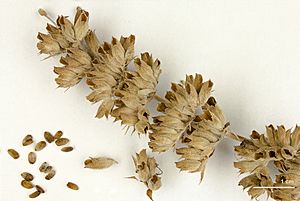White sage facts for kids
Quick facts for kids White sage |
|
|---|---|
 |
|
| Scientific classification | |
| Genus: |
Salvia
|
| Species: |
apiana
|
Salvia apiana, often called white sage, bee sage, or sacred sage, is a type of evergreen shrub. This means it stays green all year round! It grows naturally in the southwestern United States and northwestern Mexico. You can mostly find it in places like Southern California and Baja California, especially in areas called coastal sage scrub, and near the edges of the Mojave and Sonoran deserts.
Contents
What Does White Sage Look Like?
White sage is a shrub that can grow to be about 1.3 to 1.5 meters (around 4 to 5 feet) tall and just as wide. Its leaves are a whitish-green color and stay on the plant all year. They are about 3 to 9 centimeters (1 to 3.5 inches) long and grow in pairs.
The leaves are covered in tiny hairs that hold special oils. If you rub the leaves, these oils are released, creating a strong, pleasant smell. In spring, tall flower stalks, sometimes a bit pink, grow above the leaves. These stalks can reach 1 to 1.3 meters (3 to 4 feet) high. The flowers themselves are white or a light purple color.
Where Does White Sage Grow?
White sage is a very common plant. It likes dry soil that drains water well, lots of sunshine, and doesn't need much water to grow. You can find it on dry hillsides in coastal sage scrub areas, chaparral (a type of shrubland), and yellow-pine forests. It grows in Southern California and Baja California, usually at elevations less than 1,500 meters (about 4,900 feet).
How Does White Sage Help Nature?
The flowers of white sage attract many different pollinators. These include bumblebees, carpenter bees, and hummingbirds. While many insects visit the flowers, only a few types of carpenter bees and one kind of bumblebee are really good at pollinating the plant. This means they help the plant make seeds.
Plant Protection
White sage has special chemicals called terpenoids and essential oils. These are like natural bug sprays for the plant! They probably help keep animals from eating the leaves and stems.
How People Use White Sage
Salvia apiana has been used for a very long time by Native American peoples living along the Pacific coast of the United States.
- Food: The seeds of white sage are a main ingredient in a traditional food called pinole. The Cahuilla people, for example, would gather many seeds. They would then mix them with wheat flour and sugar to make a type of porridge or biscuits. The leaves and stems were also a traditional food for the Chumash people and other nearby communities.
- Traditional Healing: Some tribes traditionally used the seeds to help remove small objects from the eye. This is similar to how Clary sage seeds were used in Europe. The Cahuilla women would also make a tea from the roots to help them feel strong and healthy after having a baby.
- Ceremonies: Different parts of the white sage plant are also used in important ceremonies by several Native American cultures.
Growing White Sage
If you want to grow Salvia apiana, it prefers a sunny spot with soil that drains water well and good air movement. White sage can easily mix with other Salvia species, especially Salvia leucophylla and Salvia clevelandii, to create new types of plants.
See also
 In Spanish: Salvia apiana para niños
In Spanish: Salvia apiana para niños


